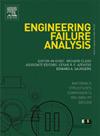Study on the creep fracture mechanism of the Mg-Al-Zn extrusion plate during creep forming
IF 5.7
2区 工程技术
Q1 ENGINEERING, MECHANICAL
引用次数: 0
Abstract
Both the creep resistance and creep forming of the light-weight Mg alloys involve the interaction between dislocations and second-phase particles. However, current researches have predominantly focused on the steady creep stage while neglecting the analysis of creep fracture behavior. In this study, the creep mechanisms and creep fracture behaviors of the Mg-Al-Zn extruded plate are analyzed, via advanced characterization techniques such as scanning electron microscopy and transmission electron microscopy. The results indicate that basal <a> slip and cross-slip are the dominant creep mechanisms under the creep conditions of 423 ∼ 463 K and 40 ∼ 100 MPa. Furthermore, <a> dislocations not only induce the transition of the dominant texture component from {0001} < 100 > to {110}<0001> component, but also contribute to the formation of dislocation networks and the dynamic precipitation of β-Mg17Al12 phase near grain boundaries. Under the combined action of dislocation activation, dislocation networks and β-Mg17Al12 phase, voids and cracks occur near these second phase and are stretched out along the creep direction, and lead to the creep failure, accelerating a theoretical foundation for Mg alloys with creep resistance or creep forming.
Mg-Al-Zn挤压板在蠕变成形过程中的蠕变断裂机理研究
轻质镁合金的蠕变抗力和蠕变成形都涉及位错与第二相颗粒的相互作用。然而,目前的研究主要集中在稳态蠕变阶段,而忽略了蠕变断裂行为的分析。本研究采用扫描电镜和透射电镜等先进表征技术,分析了Mg-Al-Zn挤压板的蠕变机理和蠕变断裂行为。结果表明,在423 ~ 463 K和40 ~ 100 MPa蠕变条件下,基底滑移和交叉滑移是主要的蠕变机制。此外,<a>;位错不仅导致主导织构成分由{0001}<; 101¯0 >;转变为{112¯0}<;0001>,还导致位错网络的形成和晶界附近β-Mg17Al12相的动态析出。在位错活化、位错网络和β-Mg17Al12相的共同作用下,这些第二相附近出现空洞和裂纹,并沿蠕变方向拉伸,导致蠕变破坏,加速了镁合金抗蠕变或蠕变成形的理论基础。
本文章由计算机程序翻译,如有差异,请以英文原文为准。
求助全文
约1分钟内获得全文
求助全文
来源期刊

Engineering Failure Analysis
工程技术-材料科学:表征与测试
CiteScore
7.70
自引率
20.00%
发文量
956
审稿时长
47 days
期刊介绍:
Engineering Failure Analysis publishes research papers describing the analysis of engineering failures and related studies.
Papers relating to the structure, properties and behaviour of engineering materials are encouraged, particularly those which also involve the detailed application of materials parameters to problems in engineering structures, components and design. In addition to the area of materials engineering, the interacting fields of mechanical, manufacturing, aeronautical, civil, chemical, corrosion and design engineering are considered relevant. Activity should be directed at analysing engineering failures and carrying out research to help reduce the incidences of failures and to extend the operating horizons of engineering materials.
Emphasis is placed on the mechanical properties of materials and their behaviour when influenced by structure, process and environment. Metallic, polymeric, ceramic and natural materials are all included and the application of these materials to real engineering situations should be emphasised. The use of a case-study based approach is also encouraged.
Engineering Failure Analysis provides essential reference material and critical feedback into the design process thereby contributing to the prevention of engineering failures in the future. All submissions will be subject to peer review from leading experts in the field.
 求助内容:
求助内容: 应助结果提醒方式:
应助结果提醒方式:


